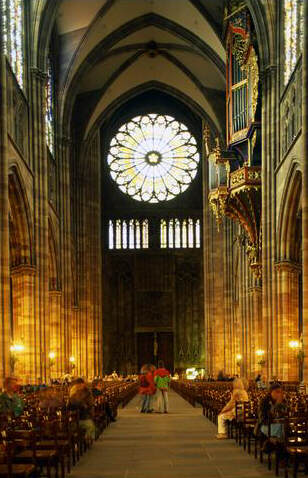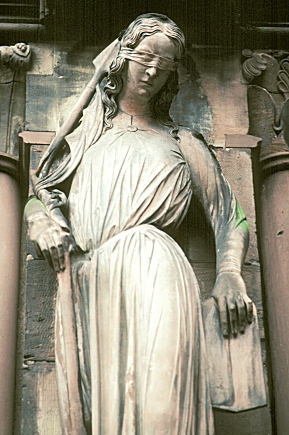 Michael Shurkin
Michael ShurkinThe Cathedral is readily visible as the train rolls into Strasbourg, and the walk from the station is short and straight. Ten minutes suffice to travel on foot from the station's bomb-pocked Wilhelmine façade to the Cathedral's astonishing West Portal, composed, as Goethe put it, of "a thousand harmonizing details." The Cathedral is simply one of the most beautiful things I have ever seen. It is as solid as the rose-tinged rock from which it was crafted, yet it is as light, ethereal, and spiritual as anything I have ever heard in a symphony hall. The single, towering steeple, more lace than stone, captures the sky and incorporates it into its structure, creating the illusion that light and air keep the tower aloft, not pillar and arch. The interior of the Cathedral similarly defies physical limitations. The impossibly vast space, the afternoon light pouring in through the rosace, the expansive peace, the infinite contained within the finite. No wonder Goethe made such a fuss.
 Yet despite the Strasbourg Cathedral's universal appeal, I find it impossible to forget even for a moment that its is quintessentially other. It is Catholic. It is German. Mine is another history and another vision of God. Even if I were willing to try, as Heine had tried, to leave behind my Jewishness, the Cathedral itself will not let me forget it. Many of its carvings depict the blindness and the subjugation of the synagogue. Every night since 1456, a special bell chimes at 10:00, the so-called Judeglock, allegedly to warn Jews to leave the city before curfew. The story, in fact, is an urban legend, and the 10:00 bell has nothing to do with Jews, but it is a legend that so many people have been telling for so long it might as well be true. Another story that definitely is true is the custom of sounding the Judenblos, the "Jews' call," on a special horn (the Grüselhorn, or "horn of terror") every night right after the 10:00 bell, a custom that began soon after the Jews allegedly poisoned the city wells during the plague and did not end until the French Revolution. The point of the horn was to remind the city of the Jews' treachery. Strasbourg's Jews needed no such reminder; the rumor about the wells prompted a massacre on St. Valentine's Day in 1349. Jews would be banned from living in the city for another 440 years.
Yet despite the Strasbourg Cathedral's universal appeal, I find it impossible to forget even for a moment that its is quintessentially other. It is Catholic. It is German. Mine is another history and another vision of God. Even if I were willing to try, as Heine had tried, to leave behind my Jewishness, the Cathedral itself will not let me forget it. Many of its carvings depict the blindness and the subjugation of the synagogue. Every night since 1456, a special bell chimes at 10:00, the so-called Judeglock, allegedly to warn Jews to leave the city before curfew. The story, in fact, is an urban legend, and the 10:00 bell has nothing to do with Jews, but it is a legend that so many people have been telling for so long it might as well be true. Another story that definitely is true is the custom of sounding the Judenblos, the "Jews' call," on a special horn (the Grüselhorn, or "horn of terror") every night right after the 10:00 bell, a custom that began soon after the Jews allegedly poisoned the city wells during the plague and did not end until the French Revolution. The point of the horn was to remind the city of the Jews' treachery. Strasbourg's Jews needed no such reminder; the rumor about the wells prompted a massacre on St. Valentine's Day in 1349. Jews would be banned from living in the city for another 440 years.
That first trip to Strasbourg nonetheless had its desired effect. I felt inspired, prepared to take Paris by storm and create great art. Or at least an impressive dissertation. I would, moreover, give free reign to my Romantic side and shelve religious discipline. Better love than Prozac, I told myself, and I quickly picked up a French graduate student working in the National Archives. I was certain that Rouge, as I shall call her, was an aristocrat. She had a strikingly upright posture and wore modest white blouses with lace details and a cameo pin at the collar. With her luxurious and exquisitely gentile blond hair tied back with a black ribbon and a mole on her cheek, she looked like an eighteenth-century lady of quality. She spoke the most charmingly precious,even antiquated, French I have ever heard, and I knew that she studied art history (eighteenth-century decorative art) at the École des Chartes, a Paris school reputedly frequented by people who were either royalists or flamboyant homosexuals or both.
Rouge turned out, in fact, to be the farthest thing from an aristocrat. Raised in Lisbon by '68ers trying to organize a Revolution, she was brought up a strict Maoist until her father was assassinated by a rival Communist cell. Her mother, as if waking up from a dream, took her daughter back to her own family in Paris and renounced politics. But while Rouge was not nobility, she had a noble Romantic sensibility worthy of any of Goethe's protagonists. Already in Lisbon she had rebelled by inventing a personal cult of the Virgin Mary. Her crypto-Catholicism sustained her through the ordeal of her father's murder, and once in Paris she buried herself in art history and frequented a weird sub-culture that of people who learn nineteenth-century formal dances and wear period costumes to large formal balls in rented chateaux. Better than Renaissance Fairs, one must admit, but still odd. I tried not to laugh when she showed me a video of her dancing a mazurka-all decked out in an 1830s hoopskirt-with a man who cut a dashing figure in his Napoleonic cavalry officer rig. Rouge liked referring to her men as "chevaliers," and she was keen on Romance of any sort. She was just the right woman for me.



strasbourg
cathedral
Michael Shurkin
the other rally
Sam Brody
what the world is &
what to do about it
Jay Michaelson
Treasure
Ron Mohring
sha'atnez
Abraham Mezrich
what is charlie kaufman doing?
Dan Friedman
josh visits the
holocaust museum
Josh Ring
saddies
David Stromberg
about zeek
archive